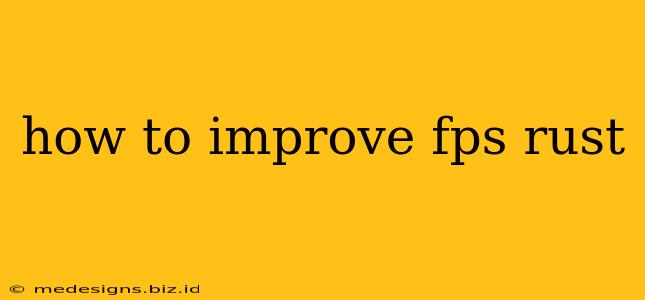Rust, with its demanding survival gameplay and stunning visuals, can sometimes struggle to maintain a high frame rate (FPS). Lagging and low FPS can significantly impact your gameplay experience, turning tense situations into frustrating ones. This guide will walk you through various techniques to optimize your Rust performance and boost your FPS, turning those frustrating moments into triumphant victories.
Understanding the Factors Affecting Rust FPS
Before diving into solutions, it's crucial to understand what factors contribute to low FPS in Rust. These include:
- Your PC's Hardware: Rust is a demanding game. A powerful CPU, a dedicated GPU with sufficient VRAM, and ample RAM are essential for smooth gameplay. Older or lower-spec hardware will naturally struggle more.
- Game Settings: In-game graphics settings directly impact performance. Higher settings demand more processing power, leading to lower FPS.
- Background Processes: Other applications running in the background can consume system resources, reducing the resources available for Rust.
- Drivers: Outdated or corrupted graphics drivers can significantly hinder performance.
- Network Issues: High ping or unstable internet connection can also cause lag and reduced FPS, even if your PC is powerful.
Optimizing Your Rust Game Settings
Tweaking your in-game settings is the quickest way to improve FPS. Experiment with these settings:
- Graphics Quality: Lowering settings like shadows, view distance, and texture quality significantly improves performance. Start by reducing these to medium or low, and adjust as needed.
- Resolution: Lowering your resolution (e.g., from 1920x1080 to 1600x900 or 1280x720) will dramatically increase your FPS.
- Anti-Aliasing: Disable or reduce anti-aliasing. This feature smooths out jagged edges but is very performance-intensive.
- VSync: Disable VSync. While it can reduce screen tearing, it can also cap your FPS and cause input lag.
- Post-Processing Effects: Turn off or reduce the intensity of post-processing effects like bloom and depth of field.
- Shadows: Lower shadow quality or turn them off completely.
Optimizing Your PC for Rust
Beyond in-game settings, several system-level optimizations can boost your FPS:
Hardware Upgrades:
- GPU Upgrade: A dedicated graphics card is crucial. Consider upgrading to a more powerful GPU if your current one is struggling. Focus on cards with higher VRAM.
- RAM Upgrade: Insufficient RAM can bottleneck performance. Ensure you have enough RAM to handle Rust and other background processes. 16GB is a good minimum, with 32GB recommended for smoother gameplay.
- CPU Upgrade: A powerful CPU is also important, particularly for multitasking.
Software Optimizations:
- Update Graphics Drivers: Ensure you have the latest drivers for your graphics card. Outdated drivers can significantly reduce performance.
- Close Background Applications: Close any unnecessary programs running in the background before launching Rust. This frees up system resources.
- Overclocking (Proceed with Caution): Overclocking your CPU or GPU can potentially boost FPS, but it carries risks and requires careful monitoring of temperatures. Improper overclocking can damage your hardware.
- Windows Updates: Keep your Windows operating system updated. Updates often include performance improvements.
Network Optimization:
- Check Your Internet Connection: A stable internet connection with low ping is crucial for smooth gameplay. Test your internet speed and troubleshoot any connectivity issues.
- Wired Connection: If possible, use a wired Ethernet connection instead of Wi-Fi for a more stable and faster connection.
- Router Optimization: Consider optimizing your router settings to reduce latency.
Additional Tips for Improved FPS in Rust:
- Reduce Clutter: Keep your base relatively tidy. Too many structures and objects can impact performance.
- Server Selection: Some servers are better optimized than others. Try different servers to see if you experience better performance.
- Use a Lower Population Server: Servers with fewer players generally have better performance.
By implementing these tips and tricks, you can significantly improve your FPS in Rust, leading to a smoother, more enjoyable gameplay experience. Remember to test and adjust your settings to find the optimal balance between visual quality and performance that suits your system. Good luck, and happy raiding!
